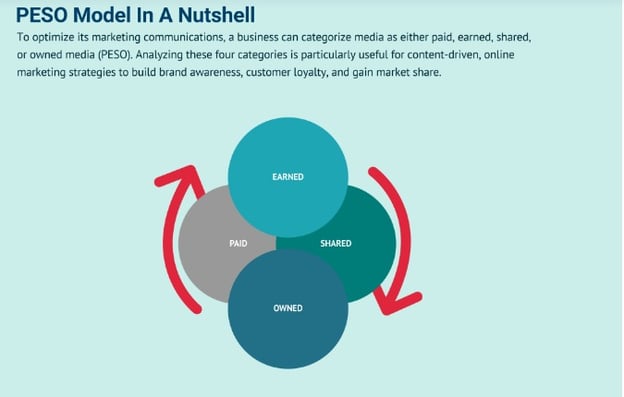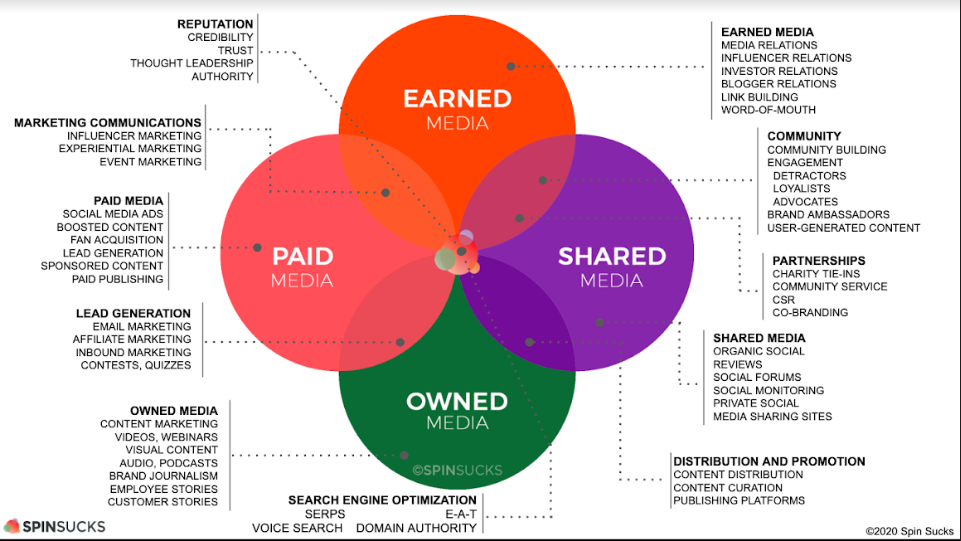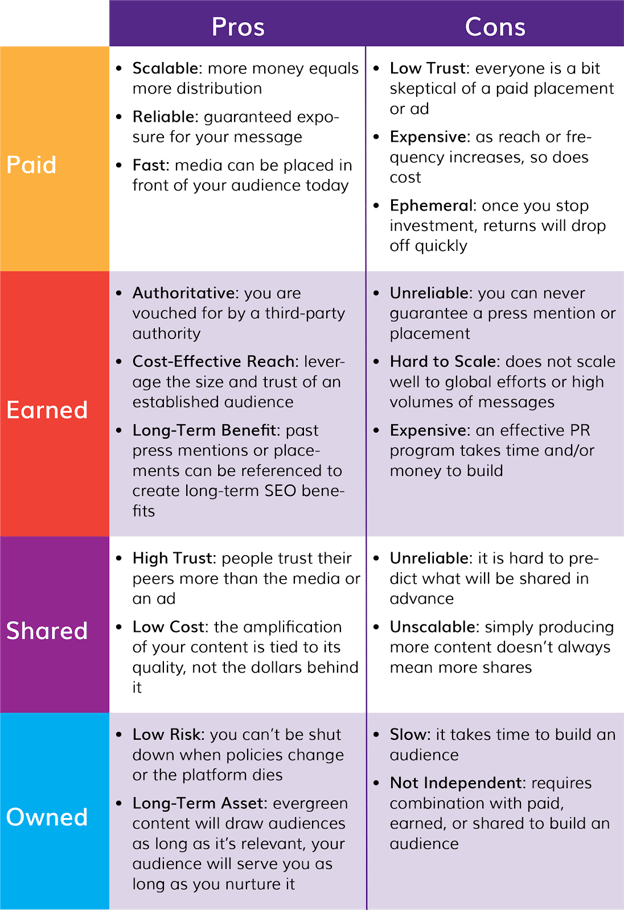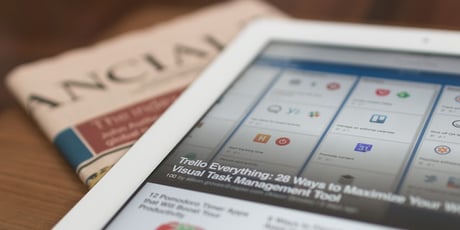-
Written by Christopher Van Mossevelde
Head of Content at Funnel, Chris has 20+ years of experience in marketing and communications.
At one time, the only way for companies to tap into their target audiences was by interrupting them with paid media channels like television advertisements, print ads, news outlets, hoardings, etc. However, the marketing landscape evolved, and permission marketing ushered in a new era. With this, models such as the PESO framework in digital marketing emerged as north stars for modern-day marketing professionals.
This blog post discusses the PESO model, its benefits, and how you can apply it for digital marketing success.
What is the PESO model?
PESO is an acronym for Paid, Owned, Earned, Shared.

Source: FourWeekMBA
Simply put, the PESO framework is a marketing model using which businesses leverage a "combination" of Paid, Earned, Shared, and Owned media. The framework helps to converge efforts across marketing channels and provides a fluid structure for marketers to base their communication strategy.
This model is sometimes also referred to as the POEM framework, where the terms stand for Paid, Owned, and Earned media.
The term was first put together in 2014 by Gini Dietrich in her book Spin Sucks Pro. However, keeping with the changes in the marketing realm over the last few years, Gini updated her model in 2020. Nonetheless, the core model continues to stand the test of time, and the revised version reflects mainly some tactical iterations instead of strategic ones.
Now, let's dive into the components of the PESO framework and take a closer look at what each of these terms implies:
-
Paid Media:
Paid media includes media types using which you can extend reach and visibility to a specific targeted audience with complete control.
As the name suggests, it is an effort requiring payment. Leveraging it, sponsors can pay and ensure their target audience sees their content. Investing in paid media sources helps to drive awareness, build a brand, and fuel conversions.
However, it's essential to remember that paid media campaigns can be a costly affair. Moreover, paid media content may have lower credibility than other media types, as viewers know the company has spent on visibility to promote its vested interests.
Some examples of Paid Media types include: Television commercials, media placements in newspapers, paid publishing, click (PPC) campaigns, social media advertising like display ads, retargeting ads, boosted or sponsored content, paid influencer campaigns, etc.
-
Earned Media:
Earned media includes media that helps brands acquire publicity without any direct payment for such endorsement. As this media coverage is not directly in the content producer's control, it needs to be "earned."
Focusing on earned media helps brands to establish authority and credibility by getting a shout from third parties that people trust. Though rewarding, scaling earned media can be challenging as the marketer has limited control over it. Moreover, if any negative publicity gets generated in its pursuit, it may turn damaging instead of benefiting the brand.
Traditionally, earned media was mainly about public relations and relationship building. For example, it involved marketers pitching journalists and getting a feature on their media outlet - online or offline. However, the scope for that has widened from journalists. Earned media efforts by the PR industry now also include outreach to bloggers, social media influencers, or web admins of top-ranking sites.
Some examples of earned media include editor or influencer-driven features of a brand, guest posts on third-party sites with backlinks, word-of-mouth publicity, and viral marketing.
-
Shared Media:
Shared Media is a relatively contemporary addition to the mainstream media model. It holds particular relevance in today’s digital marketing age. Essentially, it includes media whose distribution is shared between two parties: the brand that creates content and a shared channel where it is hosted.
Shared Media includes content assets shared on social platforms like LinkedIn, Instagram, and so on. Shared media also includes reviews on sites like Yelp, Google, and G2. Since each of these social media platforms comes with its own nuances, a marketer has limited control over the content once it's published there. Thus, when posting on shared media channels, marketing experts must be careful, as small mistakes can lead to chain reactions that may prove damaging.
-
Owned Media:
As the name suggests, owned media includes any content a business owns and creates for publishing on its owned channels, like the company website or other company-owned domains. Consequently, they have complete control over the messaging involved with it.
It's important to understand here that content posted on the company’s social media handles, such as the LinkedIn company page or Facebook business page, doesn't come under owned media. That's because its ownership and control of those platforms lie with a third party.
While each of the elements of Paid, Earned, Owned, and Shared media have distinct scopes, their implementation can overlap in practice.
Paid, Earned, Shared, and Owned Media: The blurring lines in the PESO model
The overlaps between Paid, Earned, Shared, and Owned Media types are easily understandable with the following example.
Suppose your leadership team decides that marketing needs to generate leads for sales. So as a marketing expert, you start by creating a content asset like a lead magnet and publish it on your website by creating landing pages. This content asset will fall under the "Owned Media" category.
Next, you decide to share it on your company's social platforms like LinkedIn and Twitter company page as a post. The same content now becomes "Shared Media."
Using it, you also run a paid campaign such as LinkedIn or Twitter ads to amplify its reach across new audiences. When you spend money promoting it, it becomes "Paid Media."
Your target audience finds your content very useful. So they start sharing it with their social network on their media handles. This social platform sharing further amplifies its reach and visibility. In this case, owned content asset also becomes "Earned Media."
Similarly, there can be several other overlaps in the PESO model branches.
- Influencer marketing, experiential marketing, and event marketing could fall under Paid and Earned media. Similar is the case for sponsored content and native advertising, as you still need to pay to get it in front of people.
- Community building, user-generated content, charity tie-ins, community service, corporate social responsibility, and co-branding can be Earned and Shared media. That's because the involvement of others needs to be earned, and community building is possible, usually only on a shared channel. Similarly, content curation, distribution, and publishing on platforms like Medium and LinkedIn Pulse may fall under both Owned and Shared media.
- Email marketing lies between Paid and Owned media, as it does require software to distribute the emails, which needs to be paid for.
Keeping these blurring lines in mind, Gini Dietrich updated the PESO model from its initial version to a revised version in 2020. However, reputation still remained at its core.

Source: Spin Sucks
What is the benefit of using the PESO model?
The main benefit of using the PESO framework is that it helps unify marketing efforts. With it, marketers can effectively achieve their objectives around generating awareness, raising authority, and catalyzing conversions across potential customers.
When approaching any marketing exercise, it is always helpful to follow a framework to tie the different objectives together. No surprise that marketing experts swear by frameworks like Hubspot's famous Flywheel (Attract, Engage, Convert) framework, the See Think Do Care model, and the Her0-Hub-Hygiene framework. The PESO model works well in conjunction with these models and helps target the marketing goals on a holistic level.
Essentially, the PESO marketing model allows leveraging the four key media categories in sync, as using them in a siloed fashion doesn't quite deliver ideal results.
Gini explains in her illustration of PESO that each of its four arenas has advantages and disadvantages. However, the right combination can generate results and three-sixty-degree visibility.

Source: Brilliant Metrics
By leveraging it as the four corners of a pyramid, marketing experts can identify gaps in their marketing and address them holistically.
For instance, simply creating excellent media cannot generate leads. That's because it may not be that discoverable and require a lot of time to build an audience. Therefore, if Owned is combined with Paid media, it could lead to quicker lead generation. For example, think of the potency of email or affiliate marketing for lead generation.
Similarly, while it's true that Paid media helps to earn the desired visibility quickly, it requires a reasonable budget to leverage it on a continued basis. To that end, leveraging a combination of Shared or Earned media can be a more feasible strategy for the long term.
This way, the overlap or combination of all four of these areas in marketing helps to create effective possibilities to market a company. In addition, when used in conjunction with one another, it amplifies marketing reach and results.
How to use the PESO model in digital marketing?
As marketers, it's an innate human tendency to focus on leveraging those media formats in which we're most comfortable. However, successfully using the PESO framework in digital marketing requires aligning the four arenas of PESO and approaching them together as a foundation.
Gini suggests it's a good idea to look at it like a pyramid with four corners and leverage all instead of one or two.
Since it is well-rounded and holistic, does one need to be an expert in all these aspects? Thankfully, not! However, it does require you to take the support of different individuals with expertise across SEO, copywriting, designing, and so on to make the most of it.
The trick to getting it right is ensuring consistency in your communications and establishing your brands' objectives before preparing the content. Once you do that, it's time to start working on creating media.
Although PESO starts with Paid and ends with Owned, the latter forms the base that constructs the other three components - Paid, Earned, and Shared Media work. Therefore, approaching it bottoms up is vital. Trying to retrofit elements into it won't work.
Successful implementation starts with content creation that adds value to the target audience. Therefore, marketers must develop a content strategy keeping in mind the target audience's needs, their brand's differentiator, and the sweet spot where they add value to the target customer.
Using that, freelancers, agencies, or in-house teams can implement.
The next step is allocating time and resources between Paid, Earned, and Shared. PESO is adaptable and fluid in that sense. It supports varying combinations depending on the brand's short and long-term goals and the supporting budget for them to fast-track marketing success.
Wrap Up
In today's saturated online landscape, attracting visibility and building relationships with potential customers can be complex. To this end, following a structured marketing strategy with the right balance of paid media, owned media, shared media, and earned media coverage is essential. The PESO model is an excellent framework to chart out your existing marketing implementation and maneuver it for success.
-
Written by Christopher Van Mossevelde
Head of Content at Funnel, Chris has 20+ years of experience in marketing and communications.
